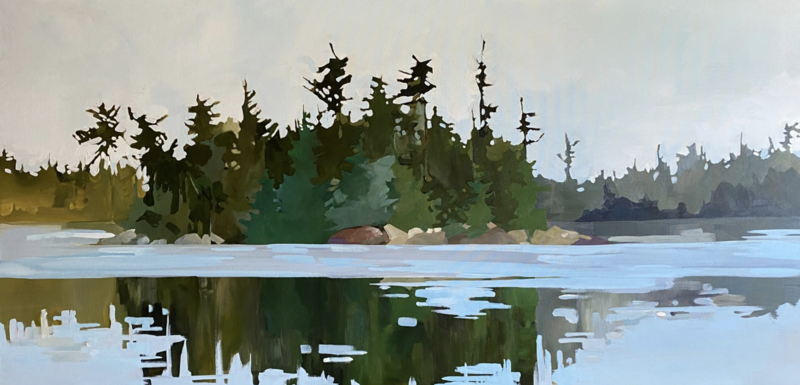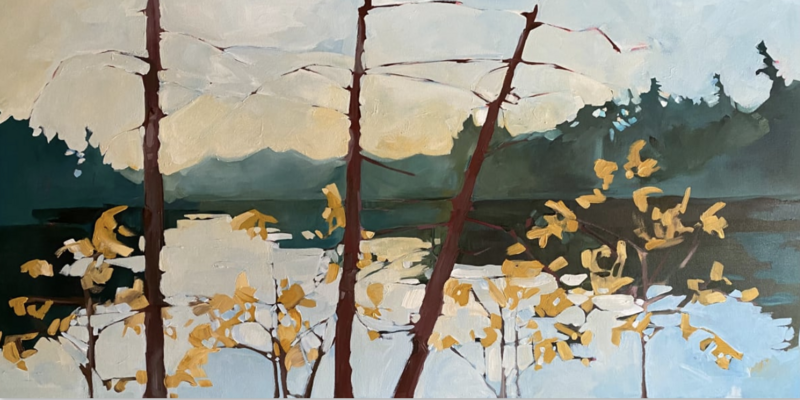.png) This artist likes taking familiar subjects and creating something new.
This artist likes taking familiar subjects and creating something new.
"There is a promise of something more than what the eye first sees," says Artwork Archive's Featured Artist Holly Ann Friesen.
"I'm intrigued by the idea of challenging the audience to see more than the original object—to overcome intuition and encourage people to think deeply about what they're experiencing."
Holly Ann Friesen started her professional career as a scientific researcher before turning to the arts. Using color and shape to examine light at both the micro and macroscopic levels, Holly's abstract paintings offer new perspectives on nature.
Her goal is to create a connection with the subject without accurately replicating it visually.
Just like nature, her pieces look different up close and from a distance. This interaction between different scale is part of the conversation she tries to create with her work.
Through painting, she hopes to help people see and experience the world more fully.
Artwork Archive had the chance to chat with Holly Ann Friesen about her creative process, how her scientific background impacts her work, and how Artwork Archive makes her art career more manageable!
You can see more of her work on Discovery and learn more about her art practice below.
.png)
Holly Ann Friesen in her studio. Photo courtesy of the artist
Do you have a favorite or most satisfying part of your process?
The most satisfying part of my process is getting in the flow near the end of a painting.
Putting in those last strokes of color makes all of the difference. I always ask myself at this stage—is this painting interesting? Am I saying what I set out to say with this painting?
How did your background as a scientific researcher influence your approach to your artwork?
My background as a researcher, particularly specializing in the sciences, has always given me focus and the drive to continue when I'm having difficulty resolving a painting.
In everything I have done as a professional, there has been an aspect of problem-solving. My process involves a lot of back and forth to resolve the imagery.
I look at nature from both a micro and macroscopic level, and just like nature, my paintings look different up close and from a distance. This interaction between different scales is a key part of the conversation I try to create with my abstracted landscapes.

Holly Ann Friesen, Reflecting, 30 x 60 x 1.5 in
Can you elaborate on how the transition from scientific researcher to artist unfolded—what inspired you to pivot toward a career in the arts?
My specialization was plant genetics.
While I was passionate about what I was doing in that field, I wanted to create something more immediately tangible. When I moved to a more rural setting in the boreal forest, translating what I saw and experienced outside every day became that.
I wanted to create something more personal with my own visual language—one that was based on my experience and memory of the natural environment.
What impact do you hope your work will have on those who view it?
As my paintings are not direct representations of the landscape, my hope is to evoke emotions related to place in the audience.
I want my work to encourage them to tap into their experiences and memories of the landscape.

Holly Ann Friesen, The Blue of Distance, 16 x 48 x 1.5 in
What does success as an artist mean to you?
For me, success is connecting with people by creating a reaction that is based on their experience and memory.
How do you handle creative blocks and find the motivation to keep creating?
Creative blocks affect everyone, and everyone has a different way of dealing with them. This is where my scientific and analytical experience becomes especially valuable in my creative process. My approach is to keep working through the block.
I start by making a list of my objectives and work through them analytically. For me, working with my hands helps me break through the block.
I may pivot, but I never give up on a piece.

Holly Ann Friesen, Exhale, 24 x 48 x 1.5 in
How do you use Artwork Archive?
I use Artwork Archive on a daily basis.
Most often, I use it to search past work as reference material. I also use it to determine what has worked and what hasn't worked for different galleries or locations. Additionally, I use it to send Inventory Reports to clients or galleries that request information.
Artwork Archive Tip:
You can track which gallery is selling the most, measure your production and sales over time, see the worth of your entire inventory, (and more) to make informed decisions about your art career using Artwork Archive's insights tool. Learn more about it here.
What advice would you give an artist who’s just starting out in their professional career?
Create.
Put your figurative pen to paper. Business plans and strategies are important, but you need to create. If you're not making anything or improving your skills, you will not have a business to plan.
Make space.
Have a dedicated space or room where you can keep your art supplies out all the time. This way, when inspiration strikes, you can create without losing your momentum.
Your dedicated space can be as simple as a cart with our supplies in the corner of the room. Just avoid storing your supplies away in a cupboard behind closed doors.
Trust the process.
You have done this before, don’t give up on yourself.
Believe in yourself and celebrate your successes.
There are ups and downs with every career. Make sure you enjoy the ups and remind yourself of those times when you experience rejection.
Value criticism.
Recognize the difference between criticism and judgment. One is helpful, one is meant to hurt.
Holly Ann Friesen in her studio. Photo courtesy of the artist's Public Profile
Holly Ann Friesen uses Artwork Archive to keep track of her artwork, examine her art business insights, and send professional reports to clients.
You can make an online portfolio, catalog your artwork, and generate reports like inventory reports, tear sheets, and invoices in seconds with Artwork Archive. Take a look at Artwork Archive's free trial and start growing your art business.



.png)


_-_image_1_and_primary_image8943.png?1460746017)
